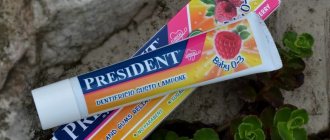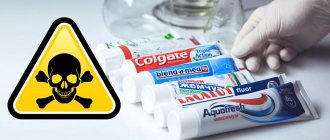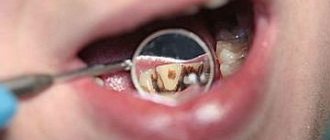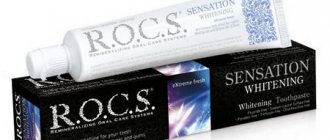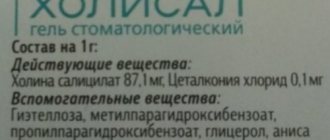Popular versions and hypotheses - the main myths about multi-colored marks on tubes
In an attempt to unravel the meaning of the multi-colored stripes on tubes of toothpaste, consumers came up with many different versions and hypotheses. It must be said right away that these are just guesses, popular misconceptions that do not correspond to reality. Let's first look at the common versions, and therefore move on to the question of what the markings on the tube actually mean.
Composition of contents – safety of active components
This is one of the most common hypotheses. Its essence is that the strip on the packaging draws the buyer’s attention to the presence or absence of natural ingredients in the product. There is an opinion among the population that the color of the mark can have the following meanings:
- a black mark indicates that the composition of the product includes only artificial components, and there are no natural ingredients in it,
- blue indicates the presence of natural ingredients in the product, but their content does not exceed 20%,
- the red marking indicates that the product is half natural, that is, the content of natural components reaches 50%,
- green - a guarantee that the product is completely organic, and only plant ingredients were used in its production.
There is a myth that the color of the stripes indicates the safety of the active ingredients.
It is not known where this rumor came from, but it has nothing to do with the truth. To make sure the composition is safe, pay attention to the list of ingredients on the package, including the small print.
Recommendations for duration of use
Another theory suggests that the stripe on the seam of the tube is directly related to recommendations regarding the duration of use of the product. If preventive pastes are suitable for daily use, then therapeutic and whitening pastes should be used in time-limited courses. This is the gradation proposed by the hypothesis:
- blue mark – prophylactic for daily use,
- green – the paste helps strengthen dental tissues, but can be used for no longer than a month,
- red - the composition is saturated with potent medicinal components, so you can brush your teeth with it for no longer than a week,
- black – a whitening agent, it is recommended to use as needed and in short courses so as not to damage the enamel.
There is a misconception that the color indicates the duration of brushing your teeth.
There is no connection between the color of the strip and the purpose of the cosmetic product. In fact, this label does not carry any useful information for the consumer.
The presence of dyes in the composition
If you believe this interpretation, then the green stripe means that the composition is completely natural, and any other color indicates the opposite. Some adherents of this theory argue that a red, black, blue or even white stripe on toothpaste is a clear sign that the product contains artificial colors. Perhaps this is another trick of marketers who are well aware of the strong association of the color green with nature and natural ingredients.
Some people believe that the colored lines indicate the naturalness of the ingredients.
Efficacy in the treatment of periodontal disease
Another fairly popular misconception is that the color of the strip on the packaging has a direct connection with the properties of the paste, in particular its effectiveness in treating periodontal disease. The gist is this: a black mark indicates the absence of any components necessary to treat the disease, a red mark means the composition contains chemicals that meet local quality standards, a green mark means the composition is completely safe. The connection between these definitions is difficult to logic, but the version still gained popularity.
Degree of abrasiveness
According to another theory, the markings indicate the degree of abrasiveness of the paste. Thus, black, blue, and sometimes brown colors indicate that the composition contains coarse abrasive particles in high concentration. You can only brush your teeth with this product for a short time - for noticeable whitening of the enamel.
“A work colleague once blurted out to me that the colored green tail on a tube of toothpaste means that it contains natural ingredients and is therefore suitable for sensitive teeth. Well, I bought it on my own. I think it’s great, and it also has a whitening effect. As a result, the enamel began to react even more strongly to everything. Then smarter people explained to me that all this was nonsense! There is no connection at all!”
Irka!13, from correspondence on the woman.ru forum
Red markings indicate the presence of abrasive components, but in small quantities. Green is a sign that the composition does not contain abrasive particles, and the product can be safely used every day without fear of its negative effect on the condition of the enamel, even with hyperesthesia, that is, its increased sensitivity.
There is an opinion that the stripes indicate the degree of abrasiveness of the product
Territorial classification
There is also an opinion: marks on the tube indicate the presence and concentration of petroleum products, and also indicate the country where the composition formula was developed. According to this theory, the black mark indicates a high petroleum content and is usually used in Asian countries as well as third world countries. The blue stripe indicates a lower content of harmful substances, and is more often found on products of American brands. Red and green marks indicate low content or complete absence of petroleum products. Such products are produced in European countries.
Cost of components included
The last hypothesis on our list states that the color of the strip directly indicates the quality and cost of the components. If expensive, high-quality ingredients were used in production, there will be a red stripe on the tube. Blue indicates the presence of components of satisfactory quality, black indicates a cheap and low-quality composition.
Wheel selection
How to choose wheel products
Before deciding on the color of automotive structures, you need to consider several factors:
- The general shade of the car - if the tone is muted, then it is better to paint the external components in a bright color. For example, on a white or silver car, black wheels look less attractive. In this option, it is better not to overdo it with color and choose simple shades.
- When decorating a car, you should pay attention to the combination of shades of the disc design. The steel option is the optimal solution for many modern cars. As a rule, designs in a neutral shade will look perfect with a car body of any color.
- Steel color is considered universal. By choosing this shade, the design of the wheels will be discreet. In addition, you can hide defects, for example, dirt on structures will not be very noticeable. Additional protection of the product is provided thanks to a reliable varnish coating. Steel designs are distinguished by universal shades. In addition, their performance qualities should be highlighted. Such models are quite resistant to any load. They almost never break and do not lose their original attractive appearance.
You may be interested in About the bolt pattern of Volkswagen Passat rims
The true meaning of the stripes - why they mark the place of adhesion
Regarding why stripes are actually needed on tubes of paste, here you first need to note that similar marks are on all cosmetics that are sold in the same tubes. These markings can come in a variety of colors and be rectangular or square in shape. However, the location of the strip always remains the same - on the tail of the tube.
Such marks are found not only on toothpaste, but also on all cosmetic products.
So, the colored stripes on a toothpaste package have nothing to do with its composition, properties or any other characteristics important to the consumer. The purpose of these marks is very simple - they are standard markings that are applied at the stage of the production process. It is necessary for the proper operation of the conveyor and for cutting blanks for future tubes. There is a special sensor on the conveyor where the workpieces pass. It is he who recognizes the mark and, based on its location, cuts the workpiece. Then the container is sealed on one side and filled with paste.
Black wheels for white and black car
Vehicle owners periodically need to buy wheels, if only to improve the appearance of their car. There are a number of requirements for wheeled structures. They must be durable, lightweight, and at the same time aesthetically pleasing. It is also extremely important to match the car make and model.
Black design for white/black cars Note!
To select the right components, it is necessary to take into account all the parameters: type, mounting diameter, size, shape, location of mounting holes (including the hub hole), as well as the presence of annular projections on the mounting flanges. An equally important point is the color of the disk structures.
At the factory, black wheel rims are marked with the following information:
- Company name;
- name of the plant;
- date of manufacture;
- information about compliance with the standard.
Many car owners are especially concerned about the color of developments. Car owners are often advised to choose a metal base for structures painted black. In this version, if the knitting needles are predominantly black, they appear thinner.
This indicator depends on the make or model of the vehicle. For example, black wheels always look attractive on both classic and sports cars.
Why are the labels on toothpaste colored?
The main thing is that the strip contrasts well with the background, and what color it will be is at the discretion of the manufacturer. Typically, dark marks are applied to light-colored packages so that the sensor can recognize them well. With dark containers the situation is the opposite - you can find light stripes on them.
Important! A standard toothpaste packaging design usually uses 4 primary colors. The barcode, stripes and text on the packaging are printed in a fifth, different color from the others - this creates the necessary contrast and ensures the readability of the printed text. Sometimes the stripes are not installed at all. In such cases, the role of an “identification mark” for the sensor is taken over by one of the design elements.
Obviously, the markings have nothing to do with the quality and composition of the toothpaste. To find out what ingredients it contains, carefully read the ingredients on the package. If the text is written in too small a font, detailed information can be found on the manufacturer's official website.
The marks can be of different colors, the main thing is that they contrast against the background of the tube
GOST requirements for marking
All cosmetics and the containers in which they are sold on the territory of the Russian Federation must meet the strict requirements of GOST1. These documents clearly state what information should be on the packaging:
- the product's name,
- its brand and trademark,
- volume of contents in the container,
- composition listing all ingredients,
- Storage conditions and shelf life,
- availability of certificates.
The labeling on the packaging must be in the language of the manufacturer and the importing country. The indicated mass may have deviations, but not more than 5% of the declared value. The materials from which the packaging is made must be safe for humans and nature as a whole. But in all these documents there is not a word about what the colored stripe on the tube means and how to apply it correctly. In other words, there are no strict rules for applying a color mark. It turns out that this point remains at the discretion of the manufacturing company, which means that it has the right to independently choose the color or do without this designation altogether.
- GOST 7983-99 (based on ISO 11609-95) - correct marking of pasty mass and its designation. GOST 14192 and 28303 – requirements for containers.
